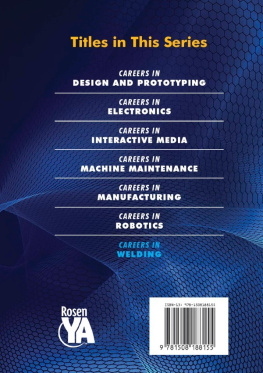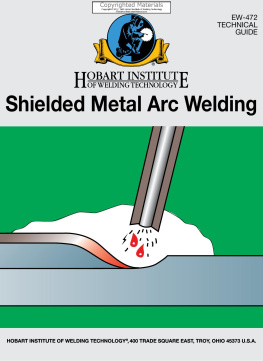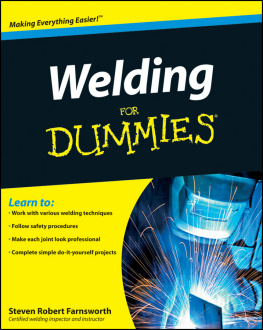WELDING
About the Authors
Don Geary is the author of numerous how-to books on a variety of shop and construction skills. He has written articles that have appeared in Popular Science, Popular Mechanics, Family Handyman, and other publications.
Rex Miller is Professor Emeritus of Industrial Technology at State University of New YorkCollege at Buffalo, where he taught technical curriculums for more than 40 years. He has authored or coauthored more than 100 books for vocational and industrial arts programs, including Welding Licensing Exam Study Guide (McGraw-Hill) and Welding Pocket Reference (Wiley).
WELDING
Don Geary
Rex Miller
Second Edition


Copyright 2011, 2000 by The McGraw-Hill Companies, Inc. All rights reserved. Printed in the United States of America. Except as permitted under the United States Copyright Act of 1976, no part of this publication may be reproduced or distributed in any form or by any means, or stored in a database or retrieval system, without the prior written permission of the publisher.
ISBN: 978-0-07-176388-2
MHID: 0-07-176388-0
The material in this eBook also appears in the print version of this title: ISBN: 978-0-07-176387-5, MHID: 0-07-176387-2.
All trademarks are trademarks of their respective owners. Rather than put a trademark symbol after every occurrence of a trademarked name, we use names in an editorial fashion only, and to the benefit of the trademark owner, with no intention of infringement of the trademark. Where such designations appear in this book, they have been printed with initial caps.
McGraw-Hill eBooks are available at special quantity discounts to use as premiums and sales promotions, or for use in corporate training programs. To contact a representative please e-mail us at bulksales@mcgraw-hill.com.
TERMS OF USE
This is a copyrighted work and The McGraw-Hill Companies, Inc. (McGraw-Hill) and its licensors reserve all rights in and to the work. Use of this work is subject to these terms. Except as permitted under the Copyright Act of 1976 and the right to store and retrieve one copy of the work, you may not decompile, disassemble, reverse engineer, reproduce, modify, create derivative works based upon, transmit, distribute, disseminate, sell, publish or sublicense the work or any part of it without McGraw-Hills prior consent. You may use the work for your own noncommercial and personal use; any other use of the work is strictly prohibited. Your right to use the work may be terminated if you fail to comply with these terms.
THE WORK IS PROVIDED AS IS. McGRAW-HILL AND ITS LICENSORS MAKE NO GUARANTEES OR WARRANTIES AS TO THE ACCURACY, ADEQUACY OR COMPLETENESS OF OR RESULTS TO BE OBTAINED FROM USING THE WORK, INCLUDING ANY INFORMATION THAT CAN BE ACCESSED THROUGH THE WORK VIA HYPERLINK OR OTHERWISE, AND EXPRESSLY DISCLAIM ANY WARRANTY, EXPRESS OR IMPLIED, INCLUDING BUT NOT LIMITED TO IMPLIED WARRANTIES OF MERCHANTABILITY OR FITNESS FOR A PARTICULAR PURPOSE. McGraw-Hill and its licensors do not warrant or guarantee that the functions contained in the work will meet your requirements or that its operation will be uninterrupted or error free. Neither McGraw-Hill nor its licensors shall be liable to you or anyone else for any inaccuracy, error or omission, regardless of cause, in the work or for any damages resulting there from. McGraw-Hill has no responsibility for the content of any information accessed through the work. Under no circumstances shall McGraw-Hill and/or its licensors be liable for any indirect, incidental, special, punitive, consequential or similar damages that result from the use of or inability to use the work, even if any of them has been advised of the possibility of such damages. This limitation of liability shall apply to any claim or cause whatsoever whether such claim or cause arises in contract, tort or otherwise.
CONTENTS
PREFACE
In this book you will learn the basics of the oxyacetylene process for joining and cutting metals. Oxyacetylene welding and cutting have been in use for over 100 years and this basic method is still in widespread use all over the world. We should mention, at this point, that we do not advise the do-it-yourselfer to teach himself or herself how to weld with any method other than oxyacetylene. We trust you will find these instructions helpful in learning how to weld. If any terms are unfamiliar to you, check the glossary. We have tried to make it as complete and helpful as possible.
We do caution you in the beginning and throughout the book that working with oxyacetylene welding or cutting equipment can be dangerous. As a welder, you must always approach any welding problem soberly. Use your best judgment at all times. Safe welding and cutting should always be your first concern. In this way, you will develop safe and sound welding habits that can result in a long and healthy welding experience. Safety is such a concern to us that we have devoted an entire chapter to pointing out how to handle welding equipment safely, as well as how to deal with mishaps such as fire around your welding shop. We suggest that you read this chapter before setting up your welding equipment or lighting your torch for the first time.
While it is entirely possible to become a proficient welder solely with the aid of this book and with many hours of practice, you should supplement the information contained in these pages with advice and instruction from a professional in the art of welding. Spend the time to seek out professional welders in your area. These people are a warehouse of information, both theoretical and practical.
If you can find the time it is recommended that you enroll in a vocational school welding class or an adult evening session usually offered at the local high school. Working with others and listening to those who have experience in welding will aid you in developing your skills associated with doing a good job of welding or cutting metals of all kinds.
You may want to visit the welding supply people to check their assortment of equipment and services. They may also be able to make recommendations as to which equipment is best for your purposes. Buying your own equipment and setting it up in a safe location is the best way to learn how to skillfully perform good welding and cutting safely.
By using this book as a reference and a textbook you will obtain a more thorough understanding of the fundamentals of gas welding so it can serve as a foundation for other types of welding.
If this book is used as a text for a formal course, an Instructors Manual is available. Please contact your McGraw-Hill sales rep for access information.
Don Geary
Rex Miller
Acknowledgments
No author works without being influenced and aided by others. Every book reflects this fact. A number of people cooperated in providing technical data and illustrations. For this we are grateful.
We would like to thank these organizations that so generously contributed information and illustrations. The following have been particularly helpful.
We would also like to thank James Brumbaugh, Paul DeGarmo, and others who have contributed so much to the welding trade through their works.
Those who have been very helpful and cooperative are listed below:
Next page







